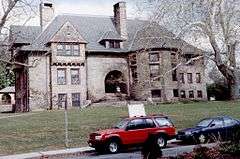Peace Dale, Rhode Island
|
Peace Dale Historic District | |
|
Peace Dale Library | |
| Location | South Kingstown, Rhode Island |
|---|---|
| Architect | Frank W. Angell; Et al. |
| Architectural style | Colonial Revival, Late Victorian, Romanesque |
| NRHP Reference # | [1] |
| Added to NRHP | October 30, 1987 |
Peace Dale (also spelled Peacedale) is a village in the town of South Kingstown, Rhode Island. Together with the village of Wakefield, it is treated by the U.S. Census as a component of the census-designated place identified as Wakefield-Peacedale, Rhode Island.
The Peace Dale Historic District was listed on the National Register of Historic Places as a historic district in 1987.[1] The historic district is roughly bounded by Kersey Rd., Oakwoods Dr., Kingstown Rd., School, Church and Railroad Sts., and contains the historic core of the village.
History
Peace Dale was founded around 1800 by South Kingstown industrialist Rowland Hazard who named the village in honor of his wife, Mary Peace Hazard. Around 1804, Hazard reputedly pioneered the use of carding machines to process wool in Rhode Island. In 1814, Hazard was also one of the first American manufacturers to employ narrow-width power looms, and also was the first woolen manufacturer to combine all his manufacturing processes under one roof, from wool carding through spinning, weaving, and dyeing.
In 1819 Rowland Hazard's sons Isaac P. Hazard and Rowland G. Hazard assumed management responsibility for the Peace Dale Manufacturing Company.[2][3] A third brother, Joseph P. Hazard, joined them as a partner in 1828, and the business took the name "R.G. Hazard & Co."[4]
Around 1820 the senior Rowland Hazard renamed the nearby industrial village to Wakefield after the town and family of the same name in England, who were friends of his. Prior to this, the village had been called McCoon's Mill for the snuff mill that by the 1820s had been converted to manufacturing woolen textiles.
After an 1845 fire destroyed one of the mill buildings,[3] the brothers built new facilities, including expanded hydropower systems and a fireproof stone factory.[5] In 1848 the partnership incorporated, becoming the Peace Dale Manufacturing Company, with Isaac P. Hazard as president and Rowland G. Hazard as secretary/treasurer.[3][4] In 1849 the business started a transition into making woolen shawls and other high-quality woolens instead of cheaper fabrics.[5]
Later in the 19th century, the sons of Rowland G. Hazard, John N. and Rowland Hazard II (1829-1898), assumed responsibility for operating the Peace Dale Mills. In 1856 Rowland Hazard II, an amateur architect, designed several new buildings in Peace Dale, including a new stone weaving mill and a stone building located across from the mills that housed offices, a store, the village post office, and a public hall. Over the next several decades he influenced the construction and design of numerous additional buildings, accounting for more than half of the built environment of modern Peace Dale.[5] Rowland Hazard II also was an initial investor in the Solvay Process Company, with works at Solvay, New York, and served as the company's first president.
Peace Dale's mills operated for woolen manufacturing until 1948, when the manufacturing machinery was removed.[6]
Contributing properties
Buildings in Peace Dale that are identified as contributing properties in the historic district include:
- Peace Dale Congregational Church, a Gothic Revival church built in 1870-72 on Columbia St.[7]
- Peace Dale Manufacturing Company Barn, a secondary structure built in 1866, on Green St.
- Peace Dale Grammar School, a Colonial Revival school built in 1923, on Kersey Rd.
- Former Peace Dale Grammar School, built in 1902 at 8 Kersey Rd., later used for storage.
- Peace Dale Manufacturing Co. Water Power Sys., an energy facility built in the 1850s on Kingstown Rd.
- Hazard Memorial/Peace Dale Library, a Romanesque former auditorium, built in 1890-91 on Kingstown Rd.
- Peace Dale Office Building, built circa 1856 at 604 Kingstown Rd.
- General Isaac Peace Rodman House at 1789 Kingstown Rd.
- Peace Dale Woolen Mill, a Greek Revival factory built in 1847 at Kingstown Rd. and Columbia St.
- Peace Dale Railroad Station (former), built in 1875-76 on Railroad St.
Gallery
| Peace Dale Congregational Church |
Hazard Memorial Peace Dale Library |
Peace Dale Railroad Station (former) |
See also
References
- 1 2 National Park Service (2007-01-23). "National Register Information System". National Register of Historic Places. National Park Service.
- ↑ Rowland Gibson Hazard, Rhode Island Manufacturer, Politician, and Philosopher, University of Rhode Island Library, Special Collections and University Archives, 2007
- 1 2 3 Peace Dale Manufacturing Company Records, Rhode Island Historical Society, Manuscripts Division
- 1 2 Rowland G. and Caroline (Newbold) Hazard Papers, Rhode Island Historical Society, Manuscripts Division
- 1 2 3 Peace Dale History and Historic Sites, Peace Dale Neighborhood Revitalization, Inc., 2007
- ↑ Historic and Architectural Resources of South Kingstown, Rhode Island: A Preliminary Report, Rhode Island Historical Preservation Commission, 1984
- ↑ "State of Rhode Island Historic Property Search". National Register of Historic Places. State of Rhode Island, Historical Preservation & Heritage Commission. 2009-07-14.
Further reading
- A Stroll Through Memory Lane Vol. I by Oliver H. Stedman. West Kingston RI : Kingston Press c. 1978
- Lost South Kingstown : with a history of ten of its early villages by Kathleen Bossy and Mary Keane. Kingston, R.I. : Pettaquamscutt Historical Society, c. 2004
- History of Washington and Kent counties, Rhode Island by J.R. Cole. New York : W. W. Preston & Co., 1889
External links
| Wikimedia Commons has media related to Peace Dale, Rhode Island. |
- Town of South Kingstown, Rhode Island
- Peace Dale Presentation
- Peace Dale, Rhode Island at DMOZ
- Peace Dale Manufacturing Company Records at Baker Library Historical Collections, Harvard Business School

